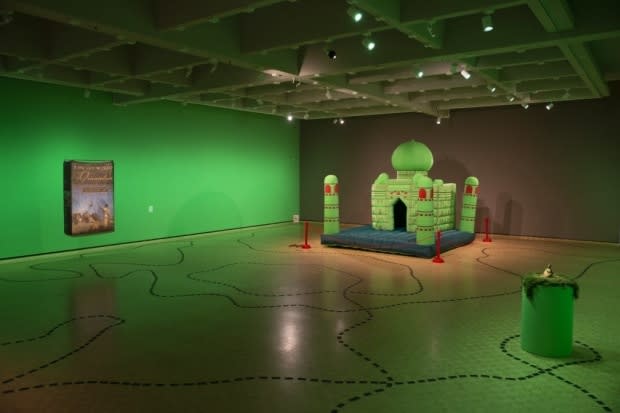Artist uncovers ethically dubious history of statue in MacKenzie Art Gallery collection
The MacKenzie Art Gallery and the University of Regina are taking on a quest to return a statue to its original home in India.
Winnipeg artist Divya Mehra sparked the investigation when she uncovered the story of how the small stone sculpture came to be in the Norman MacKenzie collection.
"Norman McKenzie was known for taking trips across the world and collecting artifacts for his collection," said John Hampton, interim executive director and CEO of the MacKenzie Art Gallery in Regina.
In 1913, on a trip down the Ganges River, he saw a sculpture near Benares, India, in a shrine that was actively being used by people in the area.
"He said, 'I want a statue like that,'" Hampton told CBC's The Morning Edition. "And he found someone that was willing to get it for him."
Hampton said this was ethically suspect, but was a common practice at the time.
"You'll find many similar and maybe even more suspect stories across all [Western institutions], which just brings into question how these collections are built."
Hampton said Mehra's findings "set a wave of motion into effect," including conversations about whether the gallery had a right to show the artifact and who the artifact truly belonged to.
He said the gallery won't be displaying the statue out of respect.
"This was part of the artist's choice in not including the statue and removing the photo from the book on display."

Norman MacKenzie's collection technically still belongs to the University of Regina, so the MacKenzie Art Gallery started conversations with the university about repatriating the work.
"We're going to make the offer to the Indian government to return this object," Hampton said. "There's no guarantee that they'll accept that offer. But we're all in agreement that it's something that we should be doing."
The gallery is also taking a closer look at the other 5,000 objects in its collection.
"It's sparked our interest to make sure that we have a fulsome history of the provenance of all of these objects and to make sure that we know if there are any more," Hampton said.
Inspired by Indiana Jones
Divya Mehra has an exhibit at the MacKenzie until January 2021. It examines some of the themes from her research — including a piece inspired by Indiana Jones.
"It's a sack of sand that weighs the same as the sculpture," Hampton said. "She wants to swipe that piece from our collection and return it to the proper home and then replace it with a bag of sand as if there's some booby traps, institutional booby traps that could prevent it."
The object was previously identified as a statue of Vishnu, but Mehra noticed that didn't seem right.
She reached out to Dr. Siddhartha Shah with the Peabody Essex Museum of South Asian Art, who correctly identified it as an Annapurna, Hindu goddess of food and nourishment.
"We're a cultural institution and we want to represent those cultures accurately and ethically, and we have to make sure that we have buy-in from the people who produce this work and where it comes from," Hampton said.
"If we don't have that right, then we don't believe that we should be showing it in that light."

